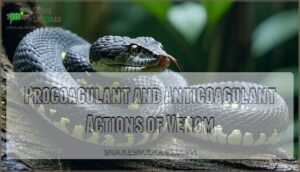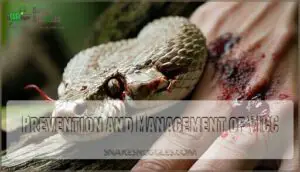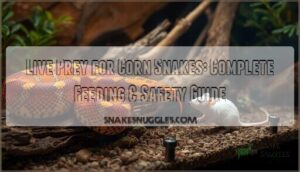This site is supported by our readers. We may earn a commission, at no cost to you, if you purchase through links.

The venom messes with your blood’s ability to clot, and at first, it can make your blood clot too fast, but at higher doses, it flips the script and stops clots from forming at all.
This can lead to dangerous bleeding, and Doctors use special blood tests to spot these changes and give antivenin if needed, which is a bit like your body’s plumbing getting clogged, then springing leaks.
There’s more to the story, especially about treatment options.
Table Of Contents
- Key Takeaways
- Malayan Pit Viper Coagulation Disruption
- Effects of Malayan Pit Viper Venom on Coagulation
- Clinical Manifestations of Envenoming
- Antivenin Administration and Adverse Reactions
- Novel Treatment Strategies for Coagulopathy
- Prevention and Management of VICC
- Future Directions in Malayan Pit Viper Research
- Frequently Asked Questions (FAQs)
- Does pit viper venom cause consumptive coagulopathy?
- What is Calloselasma rhodostoma (Malayan pit viper)?
- Why is poly-specific antivenom used in pit vipers?
- How does VICC affect coagulation?
- How does snake venom affect coagulation?
- What are the effects of pit vipers?
- How venomous is a Malayan pit viper?
- What are the complications of the viper snake?
- What are the complications of Malayan pit viper?
- How to treat coagulopathy in snake bite?
- Conclusion
Key Takeaways
- You’ll face both fast clotting and dangerous bleeding if you’re bitten by a Malayan pit viper, as the venom disrupts your blood’s ability to clot properly.
- You need quick medical attention and lab tests to spot coagulopathy early, since untreated bites can lead to life-threatening bleeding or organ damage.
- You’ll likely get antivenin as the main treatment, but doctors may also use plasma, clotting factors, and close monitoring to manage your recovery.
- You should watch for allergic reactions to antivenin and understand that newer, targeted therapies are being developed to improve outcomes after viper bites.
Malayan Pit Viper Coagulation Disruption
When a Malayan pit viper bites you, its venom can quickly upset how your blood clots.
You might notice problems with bleeding or bruising because the venom makes your blood clot too much or not enough.
Overview of Coagulopathy in Snake Bites
Snakebite coagulopathy is no walk in the park. When malayan pit viper venom enters your bloodstream, it throws your clotting system into chaos.
Watch for these dangers:
- Uncontrolled bleeding
- Organ damage
- Sudden drop in blood pressure
- Risk of death
Understanding venom mechanisms, using diagnostic tests, and knowing treatment options are essential for clinical management of venom-induced consumptive coagulopathy.
Pathophysiology of Coagulation Disorders
The Malayan pit viper venom’s pathophysiology is like a tug-of-war inside your blood.
Your blood’s clotting system gets pulled in every direction, caught in a battle between clots and bleeding.
It sparks venom mechanisms that set off Factor X and trigger a flood of thrombin. Suddenly, clots form, but the venom’s ancrod activity then breaks them down.
This leads to venom-induced consumptive coagulopathy, with DIC pathways and platelet dysfunction causing chaos. PLA2 enzymes may also contribute to this process.
Here’s what’s happening:
- Factor consumption outpaces replacement
- Fibrinolysis impact destroys weak clots
- Platelet dysfunction worsens bleeding
That’s the tricky dance behind this snakebite coagulation disorder.
Laboratory Tests for Coagulation Disorders
Blood tests are your compass for managing coagulation disorders.
You’ll see prothrombin time (PT), activated partial thromboplastin time (aPTT), platelet count, and D-dimer. These reveal clotting profiles, but traditional tests have limitations.
Thromboelastography (TEG) offers early detection and better VICC diagnosis. A platelet evaluation kit can help monitor platelet levels effectively.
Use the table below to compare test features:
| Test | What It Shows |
|---|---|
| PT | Clotting speed |
| aPTT | Internal pathway issues |
| Platelet count | Platelet number |
| D-dimer | Clot breakdown |
Effects of Malayan Pit Viper Venom on Coagulation
When a Malayan pit viper bites you, its venom can quickly upset the way your blood clots.
You might think your body can handle a small snake, but this venom can cause both too much clotting and dangerous bleeding at the same time.
Procoagulant and Anticoagulant Actions of Venom
When malayan pit viper venom enters your bloodstream, it creates a coagulation disruption that’s both fascinating and dangerous.
This venom balance operates like a biological double-edged sword, acting as both procoagulant and anticoagulant depending on concentration levels.
Here’s how the venom effects unfold:
- Factor V activation – The venom directly activates this clotting factor, speeding up initial coagulation
- Factor X manipulation – It transforms Factor X into its active form, triggering the coagulation cascade
- Thrombin generation – The venom causes explosive thrombin production, leading to rapid clot formation
- Fibrin formation disruption – Despite creating clots, the venom produces weak, unstable fibrin that breaks down quickly
This dual action explains why victims experience both bleeding and clotting problems simultaneously.
This is due to the venom containing both procoagulant and anticoagulant properties.
Impact on Blood Clotting Factors and Platelet Function
When malayan pit viper venom enters your bloodstream, it triggers a complex cascade affecting your coagulation factors and platelet function.
The venom causes Factor Consumption through dual mechanisms – at low concentrations, it accelerates Fibrin Formation by activating factors V and X, creating unstable clots with poor Clot Stability.
Higher concentrations produce anticoagulant effects, disrupting normal Hemostatic Balance. This coagulation disorder manifests as platelet function disruption in 30.5% of patients, with abnormal clotting times occurring in 73.7% of cases.
The venom’s thrombin-like enzymes convert fibrinogen to weak, short-lived fibrin, while simultaneously activating Platelet Activation pathways. This dual action disrupts your blood clotting mechanisms, creating dangerous imbalances between clot formation and dissolution that can lead to both bleeding and thrombotic complications.
Computerized thromboelastography can offer insights into coagulation during envenomation.
Clinical Implications of Coagulopathy
When coagulopathy strikes, you’re facing a medical emergency that demands immediate attention.
Coagulopathy isn’t just a complication—it’s a race against time that calls for urgent action.
The Malayan pit viper’s venom creates a perfect storm in your bloodstream, disrupting normal clotting mechanisms and triggering life-threatening complications.
- Mortality risks skyrocket without prompt intervention
- Organ damage spreads as bleeding disorders take hold
- Treatment delays worsen patient outcomes substantially
Coagulation monitoring becomes critical for tracking hemostatic complications and preventing long-term sequelae from this dangerous coagulation disorder.
Clinical Manifestations of Envenoming
When you’re bitten by a Malayan pit viper, you’ll face both local problems at the bite site and serious body-wide effects that can be life-threatening.
The venom disrupts your blood’s ability to clot properly, leading to dangerous bleeding that requires immediate medical attention.
Local and Systemic Effects of Envenoming
Experiencing a Malayan pit viper bite creates immediate local effects including severe pain, swelling, and Local Tissue Damage at the wound site.
Systemic effects quickly follow, causing Systemic Bleeding, coagulation disruption, and potential Organ Involvement.
Early Pain Management and medical intervention are critical to prevent dangerous complications from spreading throughout your body.
Similar symptoms can be seen after a bite from a Russell’s viper, which can lead to acute renal failure.
Bleeding Disorders and Hemostatic Complications
The dangerous dance between your blood’s natural healing system and venom creates a perfect storm of complications.
When Malayan pit viper venom hijacks your coagulation cascade, bleeding severity escalates rapidly, turning minor wounds into life-threatening hemorrhages.
- Venom-induced bleeding: Fibrinogen depletion and platelet dysfunction create uncontrolled bleeding episodes
- Hemostatic monitoring: Regular lab tests track coagulation disorder progression and guide transfusion strategies
- VICC prognosis: Early detection of hemostatic complications determines outcomes and supportive therapies effectiveness
Management and Treatment of Envenoming
Quick action saves lives when dealing with Malayan pit viper bites. You’ll need antivenom therapy as your first line of defense, with 86.2% of patients receiving antivenin administration to neutralize those dangerous toxins.
Don’t wait – early treatment prevents serious complications. Your supportive care plan should include wound management, pain control, and careful monitoring.
Watch for signs of VICC and bleeding disorders that can sneak up fast. Hemostatic resuscitation might be necessary if bleeding gets severe. To manage severe bleeds, consider the use of specialized hemostatic agents.
Treatment Protocols Description
Consider antivenom alternatives and transfusion protocols if traditional viper bite treatment isn’t working. Your monitoring strategies should track coagulation factors closely – hemostatic management can make the difference between recovery and disaster.
Antivenin Administration and Adverse Reactions
When you receive antivenin for Malayan pit viper envenoming, you’re getting a life-saving treatment that can reverse coagulation problems but comes with its own risks.
Understanding proper administration timing and recognizing adverse reactions helps guarantee you get the best possible outcome while minimizing complications.
Indications and Contraindications for Antivenin Use
After spotting the signs of Malayan pit viper envenoming, you might wonder when antivenin is the right call.
Antivenin Indications include severe bleeding, rapid swelling, or lab results showing coagulopathy.
But don’t forget Antivenin Contraindications—like known antivenin allergies, mild symptoms, or certain health conditions.
Special care is needed for Pediatric Antivenin and Pregnancy Considerations.
Sometimes, antivenom therapy faces Antivenin Resistance, making antivenom efficacy tricky.
Before antivenin administration, check:
- Patient’s allergy history
- Severity of symptoms
- Underlying health issues
Think before you act—safety first.
Adverse Reactions to Antivenin and Their Management
During antivenin administration, you might face allergic reactions like antivenin hypersensitivity, infusion reactions, or even anaphylaxis.
Your care team will watch for signs such as rash or trouble breathing.
If anaphylaxis hits, quick anaphylaxis management is key.
Serum sickness can show up days later.
Understanding antivenin reaction symptoms is essential for prompt intervention.
Antivenom therapy is safe when monitored, but antivenom alternatives exist if allergies occur.
Efficacy of Antivenin in Treating Coagulopathy
While antivenin remains the gold standard for treating Malayan pit viper envenoming, its effectiveness against coagulopathy isn’t always guaranteed.
Early administration improves outcomes, but some patients still experience persistent bleeding despite treatment.
The key lies in proper dosage optimization and timing.
Antivenin Effectiveness Factors:
- Dosage Optimization – Higher doses may be needed for severe coagulopathy cases
- Timing – Early treatment within hours prevents irreversible coagulation damage
- Combination Therapies – Supportive care with blood products enhances antivenom therapy
- Long-term Outcomes – Some patients develop resistance development requiring extended monitoring
Novel Treatment Strategies for Coagulopathy
Traditional antivenom treatments for Malayan pit viper envenomation can’t always fix the complex coagulation problems that develop after a bite.
You’ll find that researchers are now testing newer approaches like recombinant clotting factors and targeted therapies that directly address the specific coagulation defects caused by the venom, utilizing targeted therapies to improve outcomes.
Recombinant Coagulation Factors and Plasma-Derived Concentrates
Three breakthrough therapies are transforming how doctors treat blood clotting disorders from Malayan pit viper bites.
Recombinant Factors offer precise coagulation control, while Plasma Concentrates provide cost-effective alternatives.
Production Methods continue advancing these life-saving treatments.
- Recombinant coagulation factors deliver targeted therapy for specific coagulation disruption
- Plasma-derived concentrates offer proven Clinical Efficacy at lower costs
- Future Research focuses on optimizing blood clotting disorder treatments
Targeted Therapies for VICC and Coagulation Defects
Moving beyond general approaches, you’ll want targeted therapies that address specific coagulation defects.
Recombinant Factors like factor VIIa rapidly control bleeding by bypassing damaged pathways. TEG Guidance helps determine which Hemostatic Resuscitation components you need – whether it’s prothrombin complex concentrates or factor XIII.
Adjunctive Therapies including anti-fibrinolytic agents prevent clot breakdown. Personalized Treatment based on your specific coagulation disorder works better than one-size-fits-all approaches.
These targeted therapies for VICC treatment restore balance without overcorrecting, giving you precise control over venom-induced consumptive coagulopathy management.
Emerging Treatment Options for Snake Bite Coagulopathy
Beyond traditional antivenom therapy, you’re seeing breakthrough treatments emerge for snake bite coagulopathy. TEG-guided therapy helps doctors make smarter treatment decisions by showing real-time blood clotting patterns.
Recombinant factors and personalized medicine approaches are changing how we tackle VICC treatment and improve antivenom efficacy.
- Hemostatic resuscitation using targeted blood products instead of blanket transfusions
- Novel antivenoms designed to neutralize specific venom components more effectively
- Adjunctive therapies like metalloproteinase inhibitors that block venom’s harmful effects
- Advanced snake bite management protocols combining multiple treatment approaches
Prevention and Management of VICC
You need to spot venom-induced coagulopathy early and treat it fast to avoid serious problems.
If you ever thought a nosebleed was annoying, wait until you see what this snakebite can do if you don’t act quickly.
Early Identification and Diagnosis of VICC
Spotting Early VICC Signs can feel like finding a needle in a haystack, but Rapid Diagnostics and Coagulation Monitoring help.
Use diagnostic algorithms and tests like TEG for early identification and diagnosis of venominduced consumptive coagulopathy. Quick action means better outcomes.
Understanding the impact on kidneys is also critical in viper envenomation cases.
Here’s a quick look:
| Test Type | What It Detects |
|---|---|
| TEG Advantages | Clot strength, lysis |
| PT/aPTT | Coagulation disorder |
The key to effective management is Early Identification and Quick Action, which can significantly improve Better Outcomes in patients with venominduced consumptive coagulopathy, making Coagulation Monitoring crucial.
Supportive Care and Antivenom Administration
After spotting VICC early, you’re in the driver’s seat for treatment.
Here’s what you need to focus on:
- Start antivenom quickly: Correct Antivenom Dosage matters—don’t wait. This step neutralizes venom and helps control bleeding.
- Supportive Therapies: Clean wounds, manage pain, and give Hemodynamic Support as needed. Sometimes, Transfusion Strategies like plasma may be required.
- Watch for reactions: Monitor for allergic responses to antivenom.
- Patient education: Explain Monitoring Coagulation and follow-up. Clear guidance can make recovery smoother and help patients feel more in control.
Monitoring and Management of Coagulation Disorders
If you’re facing VICC, regular coagulation monitoring is key.
Check coagulation profiles and use thromboelastography TEG for real-time updates.
Adjust transfusion strategies and hemostatic resuscitation as needed.
Factor concentrates may help if bleeding recurs.
TEG implementation helps guide VICC treatment and avoids overuse of blood products.
Set a monitoring frequency that matches patient risk, and always watch for sudden changes or recurrent bleeding.
Future Directions in Malayan Pit Viper Research
You might think snake research is all about scary bites, but it’s really about finding better ways to help people.
In the future, you’ll see new antivenoms, smarter tests, and more teamwork to make snakebite treatment safer and faster.
Development of New Antivenoms and Treatment Strategies
As new ways to prevent and manage VICC are explored, researchers are turning their attention to better Antivenom Alternatives and advanced antivenom development.
Here’s what’s on the horizon:
- Recombinant Antivenoms: Lab-made for higher safety and less risk of reactions than traditional antivenoms.
- Targeted Therapies: Tackle specific clotting problems caused by venom, making treatment more precise.
- Personalized Treatment: Uses VICC Biomarkers to guide therapy for each patient.
- Phospholipase A2 Inhibitors: Block venom’s main toxins, offering another layer of protection.
Advances in Coagulation Monitoring Technologies
With today’s tech, you can use point-of-care testing and viscoelastic assays like thromboelastography (TEG) for real-time coagulation monitoring.
Microfluidic devices and artificial intelligence help track coagulation profiles, making it easier to spot trouble fast.
Remote monitoring adds another layer of safety, and these tools let you catch changes early, so you can treat Malayan pit viper bites with confidence.
Collaboration and Research Priorities for Snake Bite Management
Building on advances in coagulation monitoring, you play a part in better snake bite management.
Teamwork matters—researchers, doctors, and public health experts must share knowledge and set research priorities.
Focus on:
- Antivenom Development and Clinical Trials
- Data Sharing and Regional Training
- Community Education for prevention
Collaboration helps tackle Malayan pit viper risks and strengthens public health education for all.
Frequently Asked Questions (FAQs)
Does pit viper venom cause consumptive coagulopathy?
When push comes to shove, pit viper venom can throw your blood into chaos by causing consumptive coagulopathy.
It uses up clotting factors, leading to bleeding problems.
Quick diagnosis and treatment are key to staying safe.
What is Calloselasma rhodostoma (Malayan pit viper)?
Calloselasma rhodostoma, or Malayan pit viper, is a venomous snake found in Southeast Asia.
You’ll spot its brown, triangular head and stout body.
Its bite packs a punch, often causing serious bleeding and tissue damage.
Why is poly-specific antivenom used in pit vipers?
You’ll see poly-specific antivenom used because it can treat bites from different pit viper species.
Since their venoms share similar toxins, one antivenom covers more ground.
It’s like having one key that fits several locks, which is why poly-specific antivenom is preferred.
How does VICC affect coagulation?
Think of VICC like a traffic jam in your bloodstream—clots form too fast, then your body runs out of supplies to keep making them.
You’ll face bleeding, easy bruising, and sometimes organ trouble if it’s not treated.
How does snake venom affect coagulation?
Snake venom disrupts your blood’s clotting system through dual mechanisms.
It contains enzymes that both promote and prevent clot formation, creating dangerous imbalances.
This leads to bleeding disorders, organ damage, and potentially life-threatening complications.
What are the effects of pit vipers?
Pit vipers deliver venom that wreaks havoc on your blood’s clotting system.
You’ll experience dangerous bleeding disorders as the venom simultaneously triggers excessive clot formation while destroying your body’s natural clotting ability, creating life-threatening imbalances.
How venomous is a Malayan pit viper?
Like a wolf in sheep’s clothing, the Malayan pit viper packs a hidden punch.
Its venom can quickly disrupt your blood’s ability to clot, leading to serious bleeding, organ damage, and, if untreated, even death.
What are the complications of the viper snake?
You might face swelling, pain, or bruising at the bite spot.
Bleeding can start from your gums or wounds.
Sometimes, organs get hurt or your blood stops clotting right, which can be life-threatening.
In rare cases, it’s life-threatening.
What are the complications of Malayan pit viper?
Bloody bruises, baffling bleeding, and bothersome blisters often follow a Malayan pit viper bite.
You could face swelling, tissue damage, or dangerous clotting problems.
Quick care is key—don’t let this sneaky snake turn your day upside down.
How to treat coagulopathy in snake bite?
First, get medical help fast.
Doctors will check your blood with lab tests.
Antivenom is the main treatment, but you might also need plasma or clotting factors.
Careful monitoring helps prevent bleeding or organ damage down the road, and it is crucial for antivenom treatment to be effective.
Conclusion
Ever wonder how malayan pit viper coagulation disruption can turn your blood from sticky to leaky?
Understanding these changes helps you spot trouble early and get the right care. Quick tests and antivenin can stop problems before they get worse.
If you ever face a bite, remember that doctors have tools to manage both clotting and bleeding. Staying alert and knowing what to expect makes all the difference when dealing with this snake’s tricky venom.
- https://academic.oup.com/milmed/article-pdf/170/4/342/21978278/milmed.170.4.342.pdf
- https://www.researchgate.net/figure/Clinical-Manifestations-of-Patients-with-Malayan-Pit-Viper-Envenomation-Reported-to_tbl2_356619540
- https://www.sciencedirect.com/science/article/abs/pii/0041010194903204
- https://pmc.ncbi.nlm.nih.gov/articles/PMC8643212/
- https://onlinelibrary.wiley.com/doi/abs/10.1111/j.1365-2141.1965.tb00113.x
















